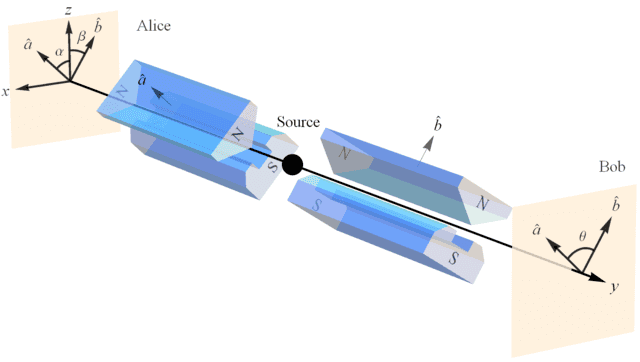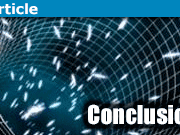Modern Physics Understood as an Unrecognized Kuhnian Revolution
People often claim on Physics Forums and in the foundations community proper that quantum mechanics is “incomplete.” Indeed, Lee Smolin recently wrote [1, p. xvii]:
I hope to convince you that the conceptual problems and raging disagreements that have bedeviled quantum mechanics since its inception are unsolved and unsolvable, for the simple reason that the theory is wrong. It is highly successful, but incomplete.
What motivated Smolin to make this claim is the same reason that Einstein thought quantum mechanics was incomplete, i.e., quantum mechanics doesn’t provide values for unmeasured observables, which is called “no counterfactual definiteness” (see this Insight on Zeilinger’s delayed choice experiment and Hardy’s device or this Insight on the GHZ state, for example). This wouldn’t be a problem per se except quantum mechanics does predict coordinated (correlated) outcomes for entangled systems that would seem to require counterfactual definiteness, i.e., what Mermin called “instruction sets,” as I explained in this Insight on the quantum liar experiment and this Insight on the Mermin device. Essentially, it’s difficult to explain the QM correlations without instruction sets, but instruction sets are not otherwise consistent with the quantum predictions. In those Insights, I proposed adynamical explanation in the block universe [2] as a means of explaining the quantum predictions, which I motivated in this Insight on special relativity and the relativity of simultaneity, this Insight on the puzzle of the Big Bang, and this Insight on the paradoxes of closed timelike curves. But, except for a hint at the end of my Insight, Why the Quantum [3], I did not offer any further justification for “ascending to the God’s-eye view” per Wilczek [4]. In this Insight, I will use “no preferred reference frame” to motivate the fundamentality of adynamical global constraints in the block universe. According to this view, quantum mechanics is complete (contrary to Smolin’s belief) and amazingly self-consistent with relativity theory. Further, per this view, the mysteries of modern physics obtain because it is an unrecognized Kuhnian revolution. In other words, modern physics is comprehensive and coherent, it is our dynamical bias that misleads us into believing otherwise. To do this, I need to start by explaining “the game of physics.”
I will start with Einstein’s own words from his paper, Physics and Reality [5]. Here is the relevant excerpt:
The whole of science is nothing more than a refinement of everyday thinking.
On the stage of our subconscious mind appear in colorful succession sense experiences, memory pictures of them, representations and feelings. In contrast to psychology, physics treats directly only of sense experiences and “understanding” of their connection. But even the concept of the “real external world” of everyday thinking rests exclusively on sense impressions.
I believe that the first step in the setting of a “real external world” is the formation of the concept of bodily objects and of bodily objects of various kinds. Out of the multitude of our sense experiences we take, mentally and arbitrarily, certain repeatedly occurring complexes of sense impression (partly in conjunction with sense impressions which are interpreted as signs for sense experiences for others), and we attribute to them a meaning — the meaning of the bodily object.
The second step is to be found in the fact that, in our thinking (which determines our expectation), we attribute to this concept of the bodily object a significance, which is to a high degree independent of the sense impression which originally gives rise to it. This is what we mean when we attribute to the bodily object “a real existence.” The justification of such a setting rests exclusively on the fact that, by means of such concepts and mental relations between them, we are able to orient ourselves in the labyrinth of sense impressions. These notions and relations, although free statements of our thoughts, appear to us stronger and more unalterable than the individual sense experience itself, the character of which as anything other than the result of an illusion or hallucination is never completely guaranteed. On the other hand, these concepts and relations, and indeed the setting of real objects and, generally speaking, the existence of the “real external world”, have justification only in so far as they are connected with sense impressions between them which they form a mental connection.
The very fact that the totality of our sense experiences is such that by means of thinking (operations with concepts, and the creation and use of definite functional relations between them, and the coordination of sense experiences to these concepts) it can be put in order, this fact is one that leaves us in awe, but which we shall never understand.
In guiding us in the creation of such an order of sense experiences, success in the result is alone the determining factor. All that is necessary is the statement of a set of rules, since without such rules the acquisition of knowledge in the desired sense would be impossible. One may compare these rules with the rules of a game in which, while the rules themselves are arbitrary, it is their rigidity alone which makes the game possible.
Let me summarize the points in Einstein’s quote that are relevant here. Physics is the study of the “bodily objects” of our “sense experiences.” As Einstein pointed out, there are already some assumptions there, so it’s best to start with “all sense experiences.” I am the spatiotemporal origin of “all sense experiences.” I assume a subset of “all sense experiences” represents other perceivers. For example, my perception of you is a subset of my “sense experiences” and I will assume you also have “sense experiences.” In Einstein’s words, “partly in conjunction with sense impressions which are interpreted as signs for sense experiences for others.” Therefore, I am the spatiotemporal origin of “my sense experiences.” I communicate with other (human) perceivers to construct a model of objective/physical reality (the “real external world”) that reconciles the disparate elements of our “sense experiences.” For example, when you view a car from its trunk and I view it from its front, we have two distinct “sense experiences.” We model these disparate perceptions by assuming two perceivers located spatially with respect to one car (thus, the wording of the preceding sentence). This is how we model the “real external world” aka our model of physical/objective reality to reconcile our disparate “sense experiences.” In Einstein’s words, “the totality of our sense experiences … can be put in order.”
We then use this model to explore regularities and patterns in the events we perceive. We mathematically describe these regularities and patterns and explore the consequences (experiments). In Einstein’s words, “operations with concepts, and the creation and use of definite functional relations between them, and the coordination of sense experiences to these concepts.” We then refine our model of physical reality as necessary to conform to our results. This allows us to explain the past, manipulate physical reality in the present (to create new technology, for example), and to predict the future. While defining physics all the way down to individual “sense experiences” may seem unnecessarily detailed, it is crucial to a key, unifying concept of modern physics that I want to introduce here. That is, the mysteries of quantum mechanics and relativity theory result from the fact that “no one’s sense experiences, such as measurement results, can evidence a favored perspective on the real external world.” This is most generally what I mean by “no preferred reference frame.” Since the “game of physics” is played to reconcile/unify the disparate perceptions of its practitioners, this is a reasonable assumption to make. Indeed, if there were preferred reference frames, the “game of physics” would be exceedingly difficult to play. So, most physicists are willing to accept this assumption. But, as it turns out, the consequences of no preferred reference frame in modern physics actually end up violating our dynamical experience, the very experience we used to create our model of physical reality to begin with!
As I explained in this Insight on special relativity, if I (and those at rest with respect to me) alone measured the speed of light from a particular source to be c, then that would clearly indicate a favored perspective on physical reality, since Maxwell’s equations tell us the speed of light is ##c = \frac{1}{\sqrt{\epsilon_o\mu_o}}##. Thus, one consequence of no preferred reference frame is an adynamical global constraint that “everyone measures the same speed of light ##c##,” that is, the light postulate of special relativity. Dynamically speaking, that is quite counterintuitive and leads to length contraction and time dilation. But, whose meter sticks are really one meter long? And whose clocks really run at a rate of one second per second? No preferred reference frame would tell us … everyones’! How can that be? Special relativity reconciles that apparent contradiction via relativity of simultaneity and block universe per Wilczek’s challenge (Figure 1). This adynamical explanation via the “all-at-once” view then resolves the mysteries of general relativity arising from dynamical explanation per the ant’s-eye view (this Insight and this Insight). Here we see that no preferred reference frame can lead to adynamical global constraints in a block universe that violate our dynamical bias.
In see this Insight on Zeilinger’s delayed choice experiment and Hardy’s device, this Insight on the GHZ state, this Insight on the quantum liar experiment, and this Insight on the Mermin device, I showed mysteries arising in a non-relativistic theory of modern physics (quantum mechanics) can also be attributed to adynamical global constraints with no dynamical counterparts. And, we now see that such adynamical global constraints result from no preferred reference frame. In special relativity, different relative velocities constituting different reference frames all measured the same speed of light ##c##. In quantum mechanics, different relative orientations of the Stern-Gerlach magnets constituting different reference frames all measured the same outcomes ##\pm \frac{\hbar}{2}## for the Bell spin-##\frac{1}{2}## states. If Alice measured ##+ \frac{\hbar}{2}##, say, for orientation ##\alpha## and Bob measured ##-0.3 \frac{\hbar}{2}## at ##\beta## (Figure 2), then we would know that Alice measured the “true value” of the angular momentum of her particle, while Bob only measured a “component” of the angular momentum for his particle. Thus, Alice’s Stern-Gerlach magnet orientation (her reference frame) would constitute a clearly favored perspective on physical reality.
So, another consequence of no preferred reference frame is an adynamical global constraint that “everyone measures the same quantum outcome ##\pm \frac{\hbar}{2}## for the Bell spin-##\frac{1}{2}## states,” as I explained in my Insights Why the Quantum [3] and Answering Mermin’s Challenge [6]. This essentially says everyone must measure the same value of Planck’s constant ##h##, regardless of their reference frame. As Weinberg states in The Trouble with Quantum Mechanics (19 Jan 2017, p. 3):
All theories agree, and experiment confirms, that when one measures the amount of spin of an electron in any arbitrarily chosen direction there are only two possible results. One possible result will be equal to a positive number, a universal constant of nature. (This is the constant that Max Planck originally introduced in his 1900 theory of heat radiation, denoted h, divided by ##4\pi##.) The other possible result is its opposite, the negative of the first.
This means our conservation principle (adynamical global constraint) can hold only “on average” between different references frames, with Alice saying Bob’s results satisfy conservation of angular momentum on average, while of course, Bob says the same thing about Alice’s results. And, this means there is no trial-by-trial conservation, that is, no causal mechanism or hidden variables to produce a dynamical counterpart for our adynamical explanation (Figure 1). Just as in relativity theory, no preferred reference frame leads to adynamical global constraints in a block universe that violate our dynamical sensibilities.

Figure 1. Comparing special relativity with quantum mechanics according to no preferred reference frame (NPRF). Because Alice and Bob both measure the same speed of light ##c## regardless of their relative motion per NPRF, Alice(Bob) may claim that Bob’s(Alice’s) length and time measurements are erroneous and need to be corrected (length contraction and time dilation). Likewise, because Alice and Bob both measure the same values for spin angular momentum ##\pm 1\left(\frac{\hbar}{2}\right)## regardless of their relative SG magnet orientation per NPRF, Alice(Bob) may claim that Bob’s(Alice’s) individual ##\pm 1## values are erroneous and need to be corrected (averaged). In both cases, NPRF resolves the mystery it creates. In special relativity, the apparently inconsistent results can be reconciled via the relativity of simultaneity. That is, Alice and Bob each partition spacetime per their own equivalence relations (per their own reference frames), so that equivalence classes are their own surfaces of simultaneity and these partitions are equally valid per NPRF. This is completely analogous to quantum mechanics, where the apparently inconsistent results per the Bell spin states arising because of NPRF can be reconciled by NPRF via the “relativity of data partition.” That is, Alice and Bob each partition the data per their own equivalence relations (per their own reference frames), so that equivalence classes are their own ##+1## and ##-1## data events and these partitions are equally valid.

Figure 2. Alice and Bob make measurements of a Bell state with various orientations of their Stern-Gerlach magnets.

Figure 3. The relativity principle, aka no preferred reference frame (NPRF), applied to the measurement of Planck’s constant ##h## leads to the kinematics of quantum mechanics (qubit Hilbert space). NPRF applied to the measurement of the speed of light ##c## leads to the kinematics of special relativity (Minkowski spacetime). Thus, QM and SR are both “principle theories” per Einstein based on the relativity principle [14].
So, we see that the apparent incompleteness of quantum mechanics results from NPRF, just as the mysteries of special relativity (Figures 1 & 3). And, in both cases, NPRF leads to adynamical global constraints in a block universe which violate our ant’s-eye dynamical bias. In other words, anthropocentricism arising from the ant’s-eye view of physical reality may lead us to believe quantum mechanics is incomplete, some going so far as to claim that it is wrong. In fact, as I showed in the many Insights referenced herein and in our book [2], all of the mysteries of modern physics are easily resolved by ascending to the “all-at-once view” per Wilczek’s challenge. In other words, we need to view physical reality like a crossword puzzle rather than a game of chess.
So, if we rise to Wilczek’s challenge and ascend to the “all-at-once view” of physical reality, we can accept that adynamical global constraints are in fact fundamental, and therefore do not need to be “explained” dynamically. Of course, this is contrary to our experience in classical physics, e.g., conservation of momentum is explained by sum of the forces equals zero, conservation of angular momentum is explained by sum of the torques equals zero, and Fermat’s principle of least time is explained by Snell’s law of refraction. We’re just not accustomed to an adynamical global constraint without a corresponding dynamical explanation. Thus, there was resistance to Einstein’s light postulate because he posited something as axiomatic that most people wanted to have explained constructively/dynamically [7]. For example, Lorentz complained [8, p. 230]:
Einstein simply postulates what we have deduced, with some difficulty and not altogether satisfactorily, from the fundamental equations of the electromagnetic field.
And Michelson of the Michelson-Morley experiment said [9]:
It must be admitted, these experiments are not sufficient to justify the hypothesis of an ether. But then, how can the negative result be explained?
In other words, even Lorentz and Michelson were apparently not satisfied with special relativity’s principle explanation, as they required some ‘deeper mechanism’ to explain why observers measure the same speed of light ##c## in different reference frames. Indeed, yet today, some physicists seek a dynamical/constructive explanation for the light postulate [7] since, “By its very nature such a theory-of-principle explanation will have nothing to say about the reality behind the phenomenon” [10, p. 331].
But again, rising to Wilczek’s challenge means accepting the fundamentality of 4D constraint-based explanation, and the ultimate reason for our adynamical global constraints is no preferred reference frame. That is, to use Einstein’s language, no one’s “sense experiences” can provide a privileged perspective on “the real external world.” So according to this view of physics, the explanatory hierarchy is actually, adynamical global constraints due to the egalitarian nature of our “sense experiences,” giving rise to dynamical stories per classical mechanics about “bodily objects” that interact via the quantum exchange of momentum per quantum mechanics. Perhaps today Lorentz would agree, since he did concede [8, p. 230]:
By doing so, [Einstein] may certainly take credit for making us see in the negative result of experiments like those of Michelson, Rayleigh, and Brace, not a fortuitous compensation of opposing effects but the manifestation of a general and fundamental principle.
The take-home message is that the mysteries of modern physics obtain because it is an unrecognized Kuhnian revolution. That is, in his 1962 book, The Structure of Scientific Revolutions, Kuhn claimed that science evolves gradually in one paradigm until new discoveries force an abrupt change to an entirely new paradigm that is incompatible with the old paradigm. This revolutionary transition is called a “Kuhnian revolution.” In the case of modern physics, we are expecting our dynamical “sense experiences” of the “real external world” to be fundamentally explicable in dynamical fashion. But, modern physics is telling us that the most fundamental fact about our dynamical “sense experiences” is that they cannot provide a favored perspective on the “real external world,” not that they are explicable in dynamical fashion. And, as it turns out, that means our dynamical “sense experiences” are only fundamentally explicable in adynamical fashion, i.e., in terms of 4D constraints per Wilczek’s “all-at-once view.” I should say however, that a block universe model of “the real external world” does not mean our dynamical experience of time is an illusion, as is sometimes claimed [11] (see this Insight). There is a difference between our individual experience of time and the block universe model for reconciling/unifying the collection of all such individual, dynamical experiences [12], but that takes us beyond physics into the modeling of consciousness [13].
Of course, this is only one way to understand modern physics, it’s certainly not mandated by anything in the physics per se. My job as a physics teacher is to find integrity and coherence in the physics I teach, so that my students may understand physics to be as comprehensive and self-consistent as possible. What I’m sharing in this Insight and its many citations is the way I reveal an underlying coherence and integrity of modern physics to my students. I do not require my students to adopt this view and, for example, I also present Many Worlds, de Broglie-Bohm, Copenhagen, Two-States Vector Formalism, etc. in my quantum mechanics course. I’m just providing another option for the reader/student here at Physics Forums.
References
- Smolin, L.: Einstein’s Unfinished Revolution: The Search for What Lies Beyond the Quantum, Penguin Press (2019).
- Silberstein, M., and Stuckey, W.M., and McDevitt, T.: Beyond the Dynamical Universe, Oxford University Press (2018).
- Stuckey, W.M., Silberstein, M., McDevitt, T., and Kohler, I: Why the Tsirelson Bound? Bub’s Question and Fuchs’ Desideratum, Entropy 21(7), 692 (2019).
- Wilczek, F.: Physics in 100 Years, Physics Today 69(4), 32–39 (2016).
- Einstein, A.: Physics and Reality, Journal of the Franklin Institute 221(3), 349-382 (March 1936).
- Stuckey, W.M., Silberstein, M., McDevitt, T., and Le, T.D.: Answering Mermin’s challenge with conservation per no preferred reference frame. Scientific Reports 10, 15771 (2020).
- Felline, L.: Scientific Explanation between Principle and Constructive Theories, Philosophy of Science 78(5), 989-1000 (2011).
- Lorentz, H.A.: The Theory of Electrons and Its Applications to the Phenomena of Light and Radiant Heat, G.E. Stechert and Co. (1916).
- Michelson, A.: The Mechanical Universe Episode 41: The Michelson-Morley Experiment, written by D. Bane, produced by Caltech and INTELECOM (1985).
- Balashov, Y., and Janssen, M.: Presentism and Relativity, British Journal for the Philosophy of Science 54(2), 327-346 (2003).
- Greene, B.: NOVA The Fabric of the Cosmos: The Illusion of Time. Air date: 9 Nov 2011.
- Rovelli, C.: Neither Presentism nor Eternalism. 6 Oct 2019.
- Silberstein, M., and Stuckey, W.M.: Re-Thinking the World with Neutral Monism: Removing the Boundaries Between Mind, Matter, and Spacetime, Entropy 22(5), 551 (2020).
- Silberstein, M., Stuckey, W.M., and McDevitt, T.: Beyond Causal Explanation: Einstein’s Principle Not Reichenbach’s. Entropy 23(1), 114 (2021).
PhD in general relativity (1987), researching foundations of physics since 1994. Coauthor of “Beyond the Dynamical Universe” (Oxford UP, 2018).










Our approach is based on empirical facts, just like special relativity. Everyone measures the same value for Planck's constant h regardless of their SG magnet orientations relative to the source –> "average-only" conservation. Everyone measures the same value for the speed of light c regardless of their velocity relative to the source –> time dilation and length contraction.
I don't study astrology, so I don't know what empirical principles they advocate and what follows from those principles observationally.
Everyone, please bear in mind that forum rules do not allow claims or arguments about one particular interpretation being "right" or "wrong" or "scientific" or "anti-scientific". Technically we are talking about interpretations of SR at the moment, not QM, but the same principle applies.
Do you think the postulates of SR are anti-scientific? We’re simply advocating a principle approach to physics a la that of SR. See this article. You may disagree with the approach, but it is based strictly on empirical and mathematical facts, just like SR. I think most physicists consider SR to be legitimate science.
All we do is organize empirical and mathematical facts into a particular explanatory hierarchy. You are free to choose another hierarchy and/or choose other names for those facts, but you cannot ignore the facts.
There is no such rule here at PF. It would be nice if all sources were available for free, but that's not always possible.
See "Re-Thinking the World with Neutral Monism: Removing the Boundaries Between Mind, Matter, and Spacetime" we just published in a Special Issue of Entropy, "Models of Consciousness." Hopefully they fix some typos and put me back into the Dept of Physics soon :-)
You might be interested in this paper my colleague and I just finished for a special issue of Entropy, "Models of Consciousness." I'm the physics half of the team, but the hard problem of consciousness long ago convinced me that science wasn't sufficient to finish my worldview :-)
Hi Ruta
Nice to hear from you.
We are doing very well out here in Australia because we took strong action early, and didn't have active cases nobody knew about very early on. The studies in California about those with antibodies was eye opening. At the moment our R0 is very very low – nearly 0. But of course you can still get local outbreaks, and when that happens – watch out:
https://www.smh.com.au/politics/nsw…ralled-at-newmarch-house-20200507-p54qq8.html
Getting back to the physics – yes there is, IMHO, likely another theory underlying QM, but I am not so sure it will be in terms Einstein would like – we will need to wait and see,
I have now read your paper, and yes it is interesting. Regarding the speed of light thing it is often difficult to get across to newbies the speed of light occurring in the theory is simply the fixing of a constant that occurs naturally. It's the speed of light for all sorts of experimental and theoretical reasons, but light isn't really what the theory is about.
Thanks
Bill
Hi Bill, hope you're staying safe!
There are certainly those who believe QM will turn out to be like thermodynamics, which worked very well and was later "explained" by stat mech. Someday we will realize that QM is just a theory that predicts behavior "on average," like temperature and pressure, via "principles." Stat mech explains the principles of thermodynamics using laws of motion for the individual constituents. Einstein called this the difference between "principle" and "constructive" theories. Here is a famous quote from Einstein:
In my Insights on Bell state entanglement and the Mermin device, I'm just supplying a "principle" for that QM phenomenon — conservation per no preferred reference frame — an articulation of empirical and mathematical facts. You can actually derive the Bell states from that principle, just like you can derive time dilation and length contraction from no preferred reference frame (whence the postulates of SR). Physicists have long since abandoned a constructive explanation of the light postulate and have become content with its explanatory power. Likewise, we may never find a concordant constructive explanation of "conservation per no preferred reference frame," in which case we will just have to be content with its explanatory power :-)
I made no comment because I also believe, like Einstein did, QM is incomplete eg nobody believes the standard model is valid beyond the Plank Scale. There are other reasons as well – what the Dickens is going on when not observed – QM it's silent on it. It may be nature is just like that – but the history of science shows things that are not known are usually eventually clarified. Of course that often leaves other issues as well.
Thanks
Bill
Two points:
First: None of this stuff about the world of the senses or conciousness really has anything much to do with @RUTA 's insight.
Second: I think you're really underselling the minimalism of what Einstein was hoping for here. He wasn't hoping that under QM there was some world corresponding to intuitive human perception. Rather in Copenhagen QM (generalizing a bit to modern terminology) we have as a primitive element:
$$Tr\left(\rho E\right)$$
The probability for some macroscopic system to react in manner ##E## (represented mathematically by a POVM element) due to the influence of a microscopic system, our knowledge of which is encapsulated in ##\rho##. Obviously it is very odd to only have a description of the microscopic in terms of reactions in the macroscopic. All Einstein was looking for was a description of the microscopic itself.
The arrogance of this post is astonishing!
Read chapters 7 and 8 of our book Beyond the Dynamical Universe. See also this paper. We discuss at length the hard problem and do not fall into the physicalist camp.
However, I do not see how you deduced a paradigm shift, i.e. it remains unrecognized by me. Yourself closes with (only one quotation of many I could have cited):
But isn't coherence an indicator, if not the definition of a constant paradigm? The only trace of a possible shift I could find is Wilczek’s "all-at-once-view", which to me sounds a bit like a resignation, i.e. raising the status quo in the rank of a revolution. This would in my opinion contradict Kuhn's concept fundamentally, as you can apply such a perspective to any paradigm, and so redefine the evolution of science by a sequence of revolutions without times in between, instead of a sequence of periods with constant paradigm.